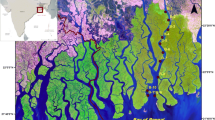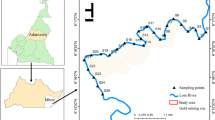Abstract
Sediment samples were collected from the Petrochemical Special Economic Zone of Mahshahr Bay, Persian Gulf, and analyzed for possible trace metal contamination by means of a chemical partitioning method. The heavy metal contents in the sediments follow the order of Al > Sr > Mn > Zn > Ni > Ba > Cr > Cu > As > Co. The degree of sediment contamination was evaluated using pollution load index (PLI), modified degree of contamination (mC d), geo-accumulation index (I geo), and enrichment factor (EF). All these indices compare present concentrations of metals to their background levels in crust and shale. In a specific area with high geological background like Mahshahr Bay, such a comparison may lead to erroneous conclusions. Due to the remarkable contribution of lithogenous fraction, as the natural component, to the bulk concentration of trace metals in the sediments of such an area, assessment of chemical hazard to the surrounding aquatic environment should not be carried out through traditional approaches. In the present study, anthropogenic portion of the metals was determined through one-step chemical sequential extraction and lithogenous portion substituted for the mean crust and shale levels in the new pollution index (RIAquatic). PLI, mC d, and I geo revealed overall low values, but EF, pollution index (I POLL), and newly developed pollution index were relatively high for all samples.




Similar content being viewed by others
References
Abrahim, G. M. S., & Parker, R. J. (2008). Assessment of heavy metal enrichment factors and the degree of contamination in marine sediments from Tamaki Estuary, Auckland, New Zealand. Environmental Monitoring and Assessment, 136(1–3), 227–238.
Al-Awadhi, F. M. A. (1999). The Year of the Ocean and its crucial importance to the Gulf. Desalination, 123(2–3), 127–133.
Anagnostou, C., Kaberi, H., & Karageorgis, A. (1997). Environmental impact on the surface sediments of the bay and the gulf of Thessaloniki according to the Geoaccumulation Index classification. Paper presented at the Rajar J, Brebbia CA (eds) Water pollution IV—measuring, modelling and prediction.
Buat-Menard, P., & Chesselet, R. (1979). Variable influence of the atmospheric flux on the trace metal chemistry of oceanic suspended matter. Earth and Planetary Science Letters, 42(3), 399–411.
Covelli, S., & Fontonlan, G. (1997). Application of a normalisation procedure in determining regional geochemical baselines. Environmental Geology, 30, 34–45.
Davis (1973). Wie Statistics and Data Analysis in Geology: Wiley.
Dean, W. E., Jr. (1974). Determination of carbonate and organic matter in calcareous sediments and sedimentary rocks by loss on ignition: comparison with other methods. Journal of Sedimentary Research, 44, 242–248.
Ergin, M., Saydam, C., Baştürk, Ö., Erdem, E., & Yörük, R. (1991). Heavy metal concentrations in surface sediments from the two coastal inlets (Golden Horn Estuary and İzmit Bay) of the northeastern Sea of Marmara. Chemical Geology, 91(3), 269–285.
Förstner, U., & Wittmann, G. T. W. (1981). Metal Pollution in the Aquatic Environment (2nd rev ed.): Springer.
Hakanson, L. (1980). An ecological risk index for aquatic pollution control.a sedimentological approach. Water Research, 14(8), 975–1001.
Karbassi, A. R., Nabi-Bidhendi, G. R., & Bayati, I. (2005). Environmental geochemistry of heavy metals in a sediment core off Bushehr, Persian gulf. Iranian Journal of Environmental Health Science & Engineering, 2(4), 255–260.
Karbassi, A. R., Monavari, S. M., Nabi Bidhendi, G. R., Nouri, J., & Nematpour, K. (2008). Metal pollution assessment of sediment and water in the Shur River. Environmental Monitoring and Assessment, 147(1–3), 107–116.
Karbassi, A. R., Heidari, M., Vaezi, A. R., Samani, A. R. V., Fakhraee, M., & Heidari, F. (2013). Effect of pH and salinity on flocculation process of heavy metals during mixing of Aras River water with Caspian Sea water. Environmental Earth Sciences, 1–9.
Karbassi, A. R., Fakhraee, M., Heidari, M., Vaezi, A. R., & Valikhani Samani, A. R. (2014). Dissolved and particulate trace metal geochemistry during mixing of Karganrud River with Caspian Sea water. Arabian Journal of Geosciences, 1–9.
Karbassi, A. R., Fakhraee, M., Vaezi, A. R., Heidari, M., (2015). An investigation on flocculation, adsorption and desorption process of heavy metals during mixing of Karganrud River with Caspian Sea water, Journal of Environmental Studies., 41 (2) (Accepted).
Lopez-Sanchez, J. F., Rubio, R., & Rauret, G. (1993). Comparison of two sequential extraction procedures for trace metal partitioning in sediments. International Journal of Environmental Analytical Chemistry, 51, 113–121.
Loska, K., & Wiechuła, D. (2003). Application of principal component analysis for the estimation of source of heavy metal contamination in surface sediments from the Rybnik Reservoir. Chemosphere, 51(8), 723–733.
Macdonald, D., Carr, R. S., Calder, F., Long, E., & Ingersoll, C. (1996). Development and evaluation of sediment quality guidelines for Florida coastal waters. Ecotoxicology, 5(4), 253–278.
MOOPAM–ROPME. (1999). Manual of oceanographic observations and pollutant analysis methods. Kuwait: MOOPAM.
Mudroch, A., & Bourbonniere, R. A. (1994). Sediment preservation processing and storage. In A. Mudroch, S. D. Mackinght (Eds), Hand book of techniques for aquatic sampling, 2nd edn. Boca Raton.
Muller, G. (1979). Schwermetalle in den Sedimenten des Rheins Veranderungenseit. Umschau, 79(24), 778–783.
Nadim, F., Bagtzoglou, A. C., & Iranmahboob, J. (2008). Coastal management in the Persian Gulf region within the framework of the ROPME programme of action. Ocean & Coastal Management, 51(7), 556–565.
Nemr, A., Sikaily, A., & Khaled, A. (2007). Total and Leachable Heavy Metals in Muddy and Sandy Sediments of Egyptian Coast Along Mediterranean Sea. Environmental Monitoring and Assessment, 129(1–3), 151–168.
Price, A. R. G. (1998). Impact of the 1991 Gulf War on the coastal environment and ecosystems: Current status and future prospects. Environment International, 24(1–2), 91–96.
Salehi, F., Abdoli, M. A., & Baghdadi, M. (2014). Sources of Cu, V, Cd, Cr, Mn, Zn, Co, Ni, Pb, Ca and Fe in Soil of Aradkooh Landfill. International Journal of Environmental Research, 8(3), 543–550.
Salomons, W., & Förstner, U. (1984). Metals in the hydrocycle. Springer
Samani, A. R. V., Karbassi, A. R., Fakhraee, M., Heidari, M., Vaezi, A. R., & Valikhani, Z. (2014). “Effect of dissolved organic carbon and salinity on flocculation process of heavy metals during mixing of the Navrud River water with Caspian Seawater.” Desalination and Water Treatment: 1–9.
Sinem Atgin, R., El-Agha, O., Zararsız, A., Kocataş, A., Parlak, H., & Tuncel, G. (2000). Investigation of the sediment pollution in Izmir Bay: trace elements. Spectrochimica Acta Part B: Atomic Spectroscopy, 55(7), 1151–1164.
Stamatis, N., Kamidis, N., & Sylaios, G. (2006). Sediment and suspended matter lead contamination in the Gulf of Kavala, Greece. Environmental Monitoring and Assessment, 115, 433–449.
Sundaray, S. K., Nayak, B. B., Lin, S., & Bhatta, D. (2011). Geochemical speciation and risk assessment of heavy metals in the river estuarine sediments—A case study: Mahanadi basin, India. Journal of Hazardous Materials, 186(2–3), 1837–1846.
Sutherland, R. A. (2000). Bed sediment-associated trace metals in an urban stream, Oahu, Hawaii. Environmental Geology, 39(6), 611–627.
Szefer, P., Szefer, K., Glasby, G. P., Pempkowiak, J., & Kaliszan, R. (1996). Heavy‐metal pollution in surficial sediments from the Southern Baltic sea off Poland. Journal of Environmental Science and Health. Part A: Environmental Science and Engineering and Toxicology, 31(10), 2723–2754.
Tam, N. F. Y., & Wong, Y. S. (2000). Spatial variation of heavy metals in surface sediments of Hong Kong mangrove swamps. Environmental Pollution, 110(2), 195–205.
Tang, W., Shan, B., Zhang, H., & Mao, Z. (2010). Heavy metal sources and associated risk in response to agricultural intensification in the estuarine sediments of Chaohu Lake Valley, East China. Journal of Hazardous Materials, 176(1–3), 945–951.
Taylor, S. R. (1964). The abundance of chemical elements in the continental crust—a new table. Geochimica Cosmochimica Acta, 28, 1273–1285.
Tessier, A., Campbell, P. G., & Bisson, M. (1979). Sequential extraction procedure for the speciation of particulate trace metals. Analytical Chemistry, 51(7), 844–851.
Tomlinson, D. L., Wilson, J. G., Harris, C. R., & Jeffrey, D. W. (1980). Problems in the assessment of heavy-metal levels in estuaries and the formation of a pollution index. Helgoländer Meeresuntersuchungen, 33(1–4), 566–575.
Turekian, K. K., & Wedepohl, D. H. (1961). Distribution of the elements in some major units of the earth’s crust. Bulletin Geological Society of America, 72, 175–192.
Vaezi, A. R., Karbassi, A. R., Valavi, S., & Ganjali, M. R. (2014). Ecological risk assessment of metals contamination in the sediment of the Bamdezh wetland, Iran. International Journal of Environmental Science and Technology, 1–8.
Yang, Y., Chen, F., Zhang, L., Liu, J., Wu, S., & Kang, M. (2012). Comprehensive assessment of heavy metal contamination in sediment of the Pearl River Estuary and adjacent shelf. Marine Pollution Bulletin, 64(9), 1947–1955.
Zhang, L., Ye, X., Feng, H., Jing, Y., Ouyang, T., Yu, X., et al. (2007). Heavy metal contamination in western Xiamen Bay sediments and its vicinity, China. Marine Pollution Bulletin, 54(7), 974–982.
Zhang, W., Liu, X., Cheng, H., Zeng, E. Y., & Hu, Y. (2012). Heavy metal pollution in sediments of a typical mariculture zone in South China. Marine Pollution Bulletin, 64(4), 712–720.
Acknowledgments
The authors are grateful to the Bandar Imam Petrochemical Company for their assistance during the field study. This study was a research project sponsored by the Research and Development Center (R&D) of Bandar Imam Petrochemical Company through grant 0871699104. We would like to express our gratitude to the Department of Environment of Iran for assistance in sampling.
Compliance with ethical standards
This study has been done through a project sponsored by the Research and Development Center (R&D) of Bandar Imam Petrochemical Company through grant 0871699104. Also, there is no conflict of interest in this study. It should be added that this article does not contain any studies with human participants or animals performed by any of the authors, and for this type of study formal consent is not required.
Author information
Authors and Affiliations
Corresponding author
Rights and permissions
About this article
Cite this article
Vaezi, A.R., Karbassi, A.R. & Fakhraee, M. Assessing the trace metal pollution in the sediments of Mahshahr Bay, Persian Gulf, via a novel pollution index. Environ Monit Assess 187, 613 (2015). https://doi.org/10.1007/s10661-015-4833-7
Received:
Accepted:
Published:
DOI: https://doi.org/10.1007/s10661-015-4833-7




